Jim Scotti's Apollo page
In Memorium: Charles "Pete" Conrad, 1930-1999
Where on the Moon is Jack Schmitt's Hammer?
While watching Apollo 17 video tapes, I saw Harrison H. "Jack" Schmitt
toss his hammer off into the distance. Recently while browsing the
Apollo Lunar Surface Journal I happened across some B&W images taken
by Gene Cernan at the end of the last EVA and what did I see in one
of those images up in the
pitch black sky? A small streaky image that looked like it might be
the hammer in flight. So, I examined some prints in the Lunar and
Planetary Lab's
Space Imagery Center and sure enough, it is the hammer which can be
seen in two consecutive images (end on in the 2nd) and in a 3rd, I found
the plume of dust from the hammer's impact! Curiosity led me to dig up
some images taken from inside the LM after the EVA and sure enough, with
the help of the plume image telling me where to look, I found several
images which show the hammer lying out on the lunar surface!
Go see the images.
Were the Moon landings faked?
There are a number of individuals who believe that the Apollo moon
landings were faked by NASA and the U.S. government. Several websites
expound this notion and even analyze images to attempt to make their
case.
See my critique of one of these pages.
Apollo Images.
Anaglyphs
(get out your red and blue 3D glasses - surely you've got
the Pathfinder/Titanic issue of National Geographic!
To order a pair of 3D glasses for viewing anaglyphs, visit
Stereoscopy.com.)
The following 3D images were made from a pair of images obtained
by the Apollo 17 astronauts in December 1972. The specific images
used here are AS17 139-21287 and 139-21288. Apollo 15 and Apollo 17
were the only flights that came close enough to get long distance
oblique views of the most prominant rayed crater on the Moon.
Copernicus is a 95 kilometer diameter crater formed by the impact
of an object about 10 kilometers in diameter about 1 billion years
ago.
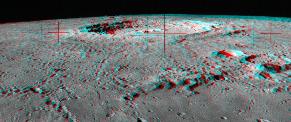 Full resolution 3-D image of Copernicus.
Full resolution 3-D image of Copernicus.
 Central region of Copernicus.
Central region of Copernicus.
 Low resolution 3-D image of Copernicus.
Low resolution 3-D image of Copernicus.
This anaglyph was composed by combining images AS12-48-7099 and
AS12-48-7100. The images were taken by the Apollo 12 crew as they
approached the Surveyor III spacecraft. The 3D affect is rather
subtle, as the photographer (Bean?) walked towards the Spacecraft
with very little translation.
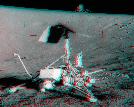 Big version
Big version
 Medium sized version
Medium sized version
During the second EVA of the Apollo 14 mission to the Fra Mauro
highlands, astronauts Alan Shepard and Edgar Mitchell climbed the
flanks of Cone crater about 340 meters in diameter and some 80 meters
above their Lunar Module, parked some 1.2 kilometers to the
southwest. During a frustrating and tiring climb, they were
unable to locate the rim of the crater, leading to great disappointment,
though they did manage to sample a boulder field near the rim which
scientifically was just as good as getting to the rim of the crater.
So how could they have ended up within about 30 meters of the rim
without knowing it?
These 2 anaglyphs are derived from a panorama taken by Alan Shepard
at station C', abut 70 meters from the rim of the crater. They are
looking in the general direction of the crater rim. Station C1 is
about 40 meters in this direction, amongst the clump of boulders in
the medium distance and was the closest that Shepard and Mitchell
got to the rim. The LM is 1.2 km away about 90 degrees of azimuth
towards the left. Images AS14-64-9101, 9102, and 9103 where used
to construct these two anaglyphs.
From AS14-64-9101/9102:
 Big version
Big version
 Medium sized version
Medium sized version
From AS14-64-9102/9103:
 Big version
Big version
 Medium sized version
Medium sized version
The following anaglyph is from the Apollo 16 mission. The rover appears at
the top of this section combining AS16-107-17445 and AS16-107-17446 taken
by John Young. Visible in the foreground is the Gnomon which was used to
provide the local vertical and a color strip for later photographic calibration.
The surface appears very uneven in this stereo view and the rocks stand out
nicely as well, particularly the rock at left. BTW, AS16-107-17446 is a
favorite of the TMLWF (The Moon Landing Was Faked) crowd and they cite
problems with reseau marks on this image, shadow directions and even a "C" which
appears on the rock at left in some versions (which is clearly dust introduced
at some point in the processing of the image for publication). The hoax
proponents do not take into account perspective issues or the unevenness of
lunar terrain in their arguments regarding shadow direction and lengths. This
stereo view should help the viewer see how shadows are affected by the terrain.
Ignore astronaut Charlie Duke in the anaglyph, as he moved between the exposure
of the two images, resulting in the ghostly red and blue images at top left.
From AS16-107-17445/17446:
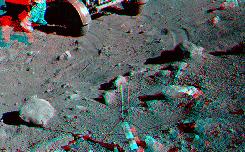
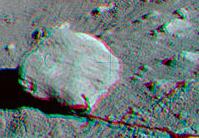
Amongst the interesting features seen from the relative closeness of
lunar orbit and considered as a possible Apollo landing site was the
Davy crater chain which may be the remnant of a Shoemaker-Levy 9 type
of impact event. Apollo 14 astronaut Stu Roosa, the lonely 3rd member
of the crew who stayed in orbit while his comrades landed on the moon,
took a set of images of this interesting area which I have used to
construct the following Anaglyph. Images AS14-73-10101 and 10102 were
used to make the following images:
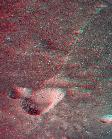 Big version
Big version
 Medium sized version
Medium sized version
Other images
AS17 134-20510
(This image was used by me to create
We're On our way, Houston!)
Lunar artwork
We're On our way, Houston!
Going Home - Apollo 17
Some Apollo books:
A Man on the Moon by Andrew Chaikin.
This is an excellent book used as the basis for From the Earth to
the Moon, the HBO mini-series on Apollo - it even got Andy Chaikin a
mention at the Emmy's by Tom Hanks! It approaches Apollo from
the astronauts point of view.
(*****)
A Man on the Moon - Illustrated 3 volume set by Andrew Chaikin.
This reworked version of Andy's original book contains lots of excellent
and rare photographs as well as all the outstanding original text (see
my previous review). An excellent excuse to re-read this great book.
(*****)
To a Rocky Moon by Don Wilhelms.
This book tells the story of Apollo from the Geologists point of
view, starting with the earliest studies of the moon to the
arguments between the cold and hot moon camps during site selection
for the Apollo Lunar landings.
(*****)
For all Mankind by Harry Hurt III.
This book approaches Apollo from the astronauts point of view.
Although it tells some interesting stories, Hurt appears to lack
a fundemental understanding of physics with clearly errant statements
and often skews the facts in favor of his opinion on an event.
These errors throw doubt on an otherwise interesting take on Apollo.
After reading part of the book, I grabbed a pen and started making
notes in the margins about all the errors and unsubstantiated opinions
I found in this book.
(**)
The Apollo Expeditions to the Moon
This book is a good overview of Apollo with plenty of illustrations.
(****)
"Chariots for Apollo: A History of Manned Lunar Spacecraft"
NASA SP-4205.
This book describes the development of the Apollo hardware which
took 12 astronauts to the surface of the Moon. Not to be confused
with the Pellegrino and Stoff book (see below).
(*****)
Chariots for Apollo. The Untold Story Behind the Race to the Moon
by Charles Pellegrino and Joshua Stoff (1985, Authors Notes and
Afterword, 1999).
This book tells Grumman's story of the building and flying of the Lunar
Module which landed the first humans on the Lunar surface between 1969
and 1972. The book is written using many personal interviews with those
involved, an important document to tell their story first hand.
(****)
Apollo: The Race to the Moon
by Charles Murray and Catherine Bly Cox (1989).
This exellent book tells the story of how NASA came to be and how it
managed to complete Kennedy's challenge of landing a man on the Moon
within the decade of the 1960s. It follows the story from the view
of those involved in making it happen in the NASA ranks (short of the
astronauts themselves). If you want to know about the flight controllers
or about those charged with creating the launch facilities or how the
Space Task Group grew out of Langley, then this is the book for you.
(*****)
Full Moon
by Michael Light, with an essay by Andrew Chaikin (1999).
This excellent collection of carefully processed images from the era
of the Apollo program is simply spectacular. Most images are from the
70mm Hasselblad images taken by the astronauts themselves, during all
parts of their flights. The images progress through the chronology
of a mission to the Moon, starting with launch and ending with their
return to Earth. In the middle are the spectacular fruits of their
photographic work, including images of the Earth, of fellow crewmembers,
of the spacecraft, of the lunar surface both from orbit and from the
surface itself. The images were scanned by the author and digitally
manipulated to bring out the best in the images.
(*****)
Exploring the Moon: The Apollo Expeditions
by David M. Harland (1999).
This book focuses on the actual exploration of the lunar surface by the
Apollo astronauts, dwelling on the J-class missions of Apollos 15, 16
and 17 since they did the lions share of geologic explorations. The
book is laced with many black and white images including many
reconstructed panoramas. If only they were reproduced at a larger
scale.
(*****)
Moon Lander by Thomas J. Kelly (2001).
This book is subtitled How we developed the Apollo Lunar Module
and who better to write such a book, but Grumman engineer and designer
of the LM, Tom Kelly. An excellent book and a must have for those
collecting Apollo historical literature. The reading is a little on the
dry side (Kelly does not have a ghost writer or co-author, so some of
the polish
found in other Apollo histories that comes from a professional writer is
missing - but that's not such a bad thing) and is occasionally
repetative, but it contains a valuable amount of details about
developing, building and flying the LM. I wish it went into even more
detail, though, and some of the later chapters on the actual flights are
brief and with little details about the engineering support of the
flight LM's. Worse, these chapters contain a number of factual errors
that I would have expected Kelly to know as well as anyone. It is well
documented with lots of references.
(****)
Virtual Apollo by Scott P. Sullivan -
Review coming soon.
Virtual LM by Scott P. Sullivan -
Review coming soon.
Saturn by Alan Lawrie -
Review coming soon.
Apollo: The Definitive Sourcebook by Richard W. Orloff and David
M. Harland -
Review coming soon.
Return to the Moon by Harrison H. Schmitt -
Review coming soon.
Astronaut autobiographies and biographies:
APOLLO: An eyewitness account by Artist/Astronaut/Moonwalker
by Alan Bean and Andrew Chaikin (1998).
Alan Bean has more than made up for pointing the Apollo 12 surface TV camera
at the sun early in his first moonwalk. He has documented the experience
of the Apollo Astronauts on the moon with some fantastic artwork. Combined
with excellent text by Andy Chaikin (See A Man on the Moon below), this
is a truly outstanding book.
(*****)
The Last Man on the Moon
by Gene Cernan and Don Davis (1999).
Gene Cernan is one of 3 astronauts who flew to the moon twice, first
as Lunar Module pilot on Apollo 10 which was the dress rehearsal for
Apollo 11, flying the LM in lunar orbit down to less than 50,000 feet
from the lunar surface. His second lunar flight was as Commander of Apollo 17,
the most scientifically ambitious and successful Apollo expedition.
This wonderful book tells Cernan's story from childhood to Naval aviator
to astronaut - an excellent read and amongst the best of the astronaut
autobiographies.
(*****)
Lost Moon: The perilous voyage of Apollo 13
by Jim Lovell and Jeffrey Kluger (1994).
Also known as Apollo 13 and has been re-released in a new edition
in 2001.
Jim Lovell flew in space 4 times and by the time of the Apollo 13 flight,
was America's most experienced astronaut having already flown to the moon
on board the first lunar voyage, Apollo 8. Apollo 13 was planned to land
in the highlands of Fra Mauro, but an explosion in an oxygen tank 200,000
miles from Earth turned the flight into a fight for survival. This excellent
book tells Lovell's view of the story of Apollo 13 and was later made into
the outstanding movie, Apollo 13 starring Tom Hanks as Jim Lovell and
directed by Ron Howard.
(*****)
Deke! An Autobiography
by Deke Slayton and Michael Cassutt (1994).
This excellent account of Deke Slaytons life not only presents his
intriguing background and post astronaut career but provides important
and fascinating clues to his sometimes mysterious methods of choosing
crewmembers for spaceflights from Gemini through Apollo.
(*****)
Moon Shot: The inside story of America's race to the Moon
by Alan Shepard and Deke Slayton (1994).
Ghost written by Jay Barbree and Howard Benedict, it is clear from
the relatively large quantity of errors that this book was not
very carefully reviewed by either Shepard or Slayton before publication.
There are some interesting angles and stories which makes the book
worth a read, however. Use caution when quoting it's "facts".
(**)
Men From Earth
by Buzz Aldrin and Malcolm McConnell (1989).
The story of Buzz Aldrin's life after his return from the Moon and how
he turned things around.
(***)
Carrying the Fire; an Astronaut's journeys
by Michael Collins (1974).
This early Astronaut autobiography by the command module pilot of
the historic Apollo 11 flight is an excellent read and very
authoritative.
His story about his thoughts on the Command Module abort handle prior
to the Apollo 11 liftoff will leave you in stitches.
This may be the best of the Apollo Astronaut autobiographies.
(*****)
Schirra's Space
by Wally Schirra and Richard Billings (1988).
(***)
The All American Boys
by Walter Cunningham and Mickey Herskowitz (1977).
This autobiography details the career of Apollo Astronaut Walter
Cunningham who flew on Apollo 7 with Wally Schirra and Donn Eisele
in October of 1968. The book gives Cunningham's personal views of
his fellow Astronauts as well as a summary of his aerospace career
through the time of its writing.
(*****)
The Way of the Explorer
by Edgar Mitchell with Dwight Williams (1996).
As an astronaut autobiography, this book fails miserably. Mitchell
provides little depth to his experiences as an astronaut, glossing over
what should be extremely fascinating events in order to get to his
goal for this book - his investigations into the human mind. I found
the book difficult to read and not very entertaining. And his views
of the paranormal and psychic phenomenon show little critical thinking
on his part. He's swallowed quickly and fully by charlatans like Uri
Geller. Even his description of what I find to be one of the most
embarrassing events of the Lunar exploration program (his attempts at
ESP experimentation during the flight of Apollo 14) are dull and
uninteresting. The final two-thirds of the book are riddled with the
usual pseudoscientific mumbo-jumboisms of the field of his
post-Apollo career. I couldn't even bring myself to finish reading
this book. It was a chore to get as far as I did.
(*)
Two Sides of the Moon
by David R. Scott and Alexi Leonov.
Review coming soon.
Rocket Man
by Nancy Conrad, Howard A. Klausner (2005).
Review coming soon - the biography of Pete Conrad.
First Man
by James R. Hansen (2005).
Review coming soon - the biography of Neil Armstrong.
Apollo Movies and Documentaries
Spacecraft Films
This series of DVDs produced by Mark Grey compiles film and TV
recordings from the Apollo missions as well as Gemini and the Saturn
rockets. Films of the assembly and roll out of the Saturn V can be
found, as well as suiting up and boarding the spacecraft. Launch films
from many different camera angles which can be selected on the fly with
audio from the launch are available. The Apollo 11 set shows the
landing film shot from the right hand window of the LM and includes
multiple audio tracks including air to ground, and the flight directors
loop and others. During the moonwalk, the TV footage and window mounted
1 frame per second film of the moonwalks can be viewed separately and a
video channel that includes both as well as the photographs as they were
taken appear. Again, different audio channels are available including
the air to ground loop and the post-flight debriefing commentary. Each
set is about $49.95 and there are sets available or planned for each
mission. This is a must have for the Apollo enthusiast. (*****)
Moon Shot (1995).
Based on the book by the same name, this 2 part documentary (4 hours)
aired originally on TBS in 1995.
It covers the American space program from its beginnings and
the selection of the Mercury Astronauts through the Lunar landings and
Deke Slayton's Apollo-Soyuz flight. It features many interviews with
Astronauts. It is somewhat biographical, using the voice of Barry
Corbin as Deke Slayton (who unfortunately passed away during the
filming), it follows the career of Deke with interviews
by his Astronaut colleagues.
(*****)
To the Moon (1999).
This 2 hour NOVA documentary aired for the 30th anniversary of the
Apollo 11 moonlanding. Similar to Moonshot, though shorter in length
and with more recent interviews, it gives excellent coverage of the
United States efforts to put a man on the moon.
Originally aired on July 13, 1999, it includes the nice touch of a
dedication at the end to Pete Conrad, who passed away just 5 days earlier.
(*****)
Apollo 13 (1995).
This movie was directed by Ron Howard and starred Tom Hanks as
mission commander James Lovell, based on Lovell's book Lost Moon
(aka Apollo 13) This movie tells the story of the flight of
Apollo 13 and follows the actual story very closely. Extreme
regard for detail and accuracy by the film crew makes this movie
stand out as the flight details, spacecraft, and mission control
are faithfully
reproduced. Use of the "Vomit Comet" - the aircraft used to fly
parabolic trajectories giving occupants 30 seconds of zero-G at
a time - in filming makes the scenes aboard the spacecraft look
and feel very real.
(*****)
From the Earth to the Moon (1998 - miniseries).
Using Apollo 13 as a springboard, Tom Hanks took the next logical
step and produced this 12 part mini-series for HBO on the entire
Apollo program. Hanks commits the film crew to stick to the historical
details and produces a generally outstanding series of films.
My favorite episodes (in airing order) included Apollo 1 which
deals with the tragedy of the Apollo 1 fire and its aftermath;
Spider which follows the design and developement of the Lunar
Module through its first manned flight on Apollo 9; Is that all there is?
the experiences of Al Bean on the flight of Apollo 12; Galileo was
Right which covers not only Apollo 15, but the geologic training of
the Apollo Astronauts, especially for this flight; and La Voyage Dans
La Lune which summarizes the Apollo program while covering the flight
of Apollo 17. My least favorite episode in this series was We
Interrupt this Program which details the media interraction with
the nearly fatal flight of Apollo 13.
From the Earth to the Moon, Signature Edition (re-released 2005).
A widescreen (16:9 format) version with some changes was re-released in
2005. The episodes are presented 3 to a disc over 4 discs (it originally
had 4 episodes per disc plus the extra material on a 4th disc), plus a 5th
disc containes extra material.
(*****)
In the Mountains of the Moon (1971?).
This NASA film on the Apollo 15 spaceflight is perhaps the best of
the NASA films on the Apollo program. It details the flight, and in
particular the scientific investigations carried out by the crew and
it's many supporting scientists and engineers during its expedition
to the Hadley Appenine landing site.
(*****)
Spacecraft Films DVDs (ongoing).
These DVD sets include Gemini, The Mighty Saturns, Apollo 8,
Apollo 11 and ultimately sets for all the missions. The DVDs include a
collection of a wealth of film and video footage from the missions including pad
camera footage, tracking shots, onboard TV transmissions - many of the clips have
never been seen before by the public or have not been seen since the time of the
flight.
(*****)
Some Apollo links:
Apollo Lunar Surface Journal
This site contains not only annotated transcripts from each of the
moonwalks, but a library of the lunar surface imagery, audio files,
video, scans of checklists, maps and a great deal more. This is perhaps
the best site on the web (and now available on CD!) for the Apollo
enthusiast.
The Apollo Saturn Reference Page
This site contains everything you'd ever want to know about the
Saturn launch vehicles as well as the Apollo Spacecraft and the
launch complexes. The information is geared towards the space
modeller.
A Field Guide to American Spacecraft
Where are the Spacecraft flown by our Astronauts? This web site
tells you where they are located. Not only manned vehicles but
boilerplates, models and so on.
Chariots for Apollo: A History of Manned Lunar Spacecraft
This web document is from the book of the same name (NASA SP-4205).
This is a great source of information about how the Apollo spacecraft
was designed and built, from the earliest concepts through the first
moon landing.
Lunar Module, Spacecraft Assembly & Test, Grumman Bethpage NY
This site contains a wealth of inside information about the only
spacecraft to land humans on another world - the Apollo Lunar Module.
Apollo Landing Sites
Where did the Apollo missions land? Dan Durda created this site which
allows you to zoom in on each of the landing sites, from the
general setting to the actual site of the landings.
NASA History Home Page
NASA's history office web site.
The "Contact Light" Project Apollo Archive
This site created and maintained by Kipp Teague contains his personal
memories of Apollo as well as a great collection of Apollo imagery and
multimedia.
Apollo 15 Flight Journal
The Apollo 15 Flight Journal does for the rest of the Apollo 15 flight
what the Apollo Lunar Surface Journal (ALSJ) does for the Apollo 15
lunar exploration. Hopefully future versions will include the other
Apollo missions.
Apollo Press Kits
The Apollo Press Kits have been scanned into PDF format and are all
available on this site. An excellent source information on each of
the missions.
Space Suits online
If you want to find out more about space suits, this is the place.
The site includes descriptions of suit hardware as well as photos
and locations of suits that are on display at various museums.
Apollo Image Atlas
Consolidated Lunar Atlas
Lunar Orbiter
Moon Trees
Apollo 14 astronaut Stuart Roosa carried tree seeds on his flight as
Command Module Pilot which were later planted and grown. This website
is dedicated to finding the lost Moon Trees and their progeny.
The Apollo Experience
Do you long to fly in space and to the Moon?
This site advertizes an Apollo based simulation of just that.
This page visited:

times since September 13, 1999
Counter courtesy of www.digits.com
Last update: July 19, 2017
 Full resolution 3-D image of Copernicus.
Full resolution 3-D image of Copernicus.
 Full resolution 3-D image of Copernicus.
Full resolution 3-D image of Copernicus.
 Low resolution 3-D image of Copernicus.
Low resolution 3-D image of Copernicus.
 Big version
Big version
 Medium sized version
Medium sized version
 Big version
Big version
 Medium sized version
Medium sized version
 Big version
Big version
 Medium sized version
Medium sized version
 Big version
Big version
 Medium sized version
Medium sized version